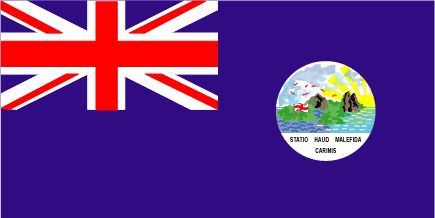
by Juan Manuel Gabino Villascán, 3 October 2000

Last modified: 2014-05-29 by zoltán horváth
Keywords: saint lucia | santa lucia | st. lucia |
Links: FOTW homepage |
search |
disclaimer and copyright |
write us |
mirrors
See also:
St. Lucia was first settled by France in 1650. During French
rule, it used the same flag as Martinique, its neighbouring
island to the north. It became British in 1814 - so the first
ensign could date at least to this time. Afterwards, the two
rulers were changed several times, but it finally remained a
British dependency into the 'modern era'. In 1939 the arms were
granted. Internal self-government was granted in 1967 (when it
became an Associated State of Great Britain). Full independence
in 1979.
Željko Heimer, 18 March 1997

by Juan Manuel Gabino Villascán, 3 October 2000
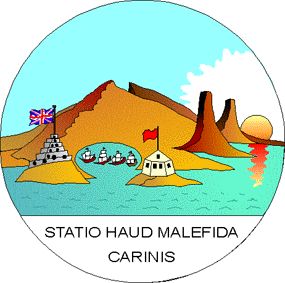
by Jaume Ollé, 18 October 2002
An earlier blue ensign had a white disc divided horizontally into two segments. The upper segment [about three quarters of the circle] had a view of St.Lucia from the west. The shore line is roughly on the diameter of the circle. [Geo17] describes it "for a badge a landscape in which appear the Pitons, twin mountains of the island, and the ever-bubbling volcano Soufriere, with a land-locked harbor in the foreground." Above Castries flies the Union flag of Great Britain on the fort. The motto is in the lower segment, black on white;
Statio Haud Malefida
Carinis
It means, 'Hardly a faithless guard for ships.' The same motto
went with the Arms used on the other Blue Ensign.
David Prothero, 15 March 1997, Nick Artimovich, 18
March 1997
This flag is illustrated in a flag chart contained in [smi75], where it is dated there as
"end of 19th Century" and in Znamierowski's "The
World Encyclopedia of Flags" [zna99]
as St. Lucia (S.XIX-1938)
Blas Delgado Ortiz, 21 September 2000
The above is the 1875 - 1937 flag. New badge approved
26th October 1937.
David Prothero, 23 September 2000
Here is the flag of Saint Lucia adopted in 1938. I got it from
the ESPASA and Bruguera Encyclopaedias.
Juan Manuel Gabino Villascán, 3 October 2000
The 1939 Flaggenbuch edition [neu92]
already includes this flag. Anyway, the design is a bit different
and more 'pictoresque'. As main differences , the sunrays are not
visible because the sun is 'drown' in the clouds, and the Union
Jack is represented with the hoist on viewer's right.
Ivan Sache, 4 October 2000
This badge was not introduced in 1938 but, with more subdued
colours, in 1875. It was reluctantly approved by the
Administrator, who wrote, "[It] is the device on the seal as
colony does not possess any arms or badge. No doubt the
simplest and best device would have been merely the name of the
colony, but we must abide by the Order in Council." (CO
323/321).
St Lucia, being one of the Windward Islands had no separate
Governor and it has often been assumed that the badge of the
island was used only on the Blue Ensign. This was not
correct for St Lucia, and probably not for the other Windward
Islands. "25 Mar 1919. St Lucia Despatch. The
colony’s badge is used only on the defaced Union Flag of the
Administrator. The Blue Ensign is used only by the Harbour
Master who defaced it with the letters ‘H M’ in white
on the fly." (ADM 116/1847B)
David Prothero, 5 October 2000
St. Lucia used a circular seal in 1875 flag.
David Prothero, 8 April 2005
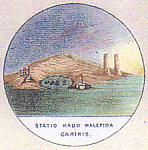
by David Prothero, 30 September 2002
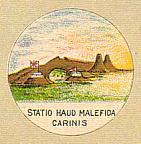
by David Prothero, 30 September 2002
The St Lucia 1875 - 1937 Blue Ensign badge above differs from
those in official flag books.
Upper badge is from an 1881 book.
Lower badge was supposed to be an improvement in a later book.
David Prothero, 30 September 2002
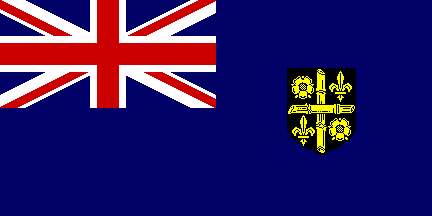
Blue Ensign
by Martin Grieve, 28 September 2002
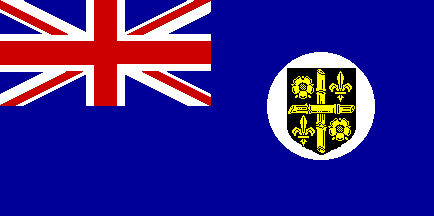
Unofficial (?)
by Željko Heimer, 29 January 1996
In use 16 August 1939 to 1967: British blue ensign defaced
with a white disc, containing the arms (black, golden cross made
of two bamboo sticks, in quarters golden heraldic rose (I and IV)
and fleur de lys (II and III). The arms had a motto (which was
not included in the flag design). There was no red or white
ensign. Reference: [smi75].
Željko Heimer, 18 March 1997
Smith (1980) says that arms were granted by royal warrant on
16 August 1939. Its Latin motto [Statio haud malefida carinis]
means "An anchorage by no means unsafe for ships'. The roses
and fleur-de-lis of the arms are for the British and French rule
the island has known, the bamboo suggesting its vegetation.
Ivan Sache, 31 January 2000
The new badge approved 26th October 1937. St Lucia had paid 50
Pounds for a badge and new seal design by the College of Arms .
David Prothero, 23 September 2000
The badge was replaced in 1937. The amendment to the
Admiralty Flag Book shows the new badge drawn on a white circle
with the notes; "On Union Flag as shown with garland for
Administrator." "On Blue Ensign with no white
circle." (CO 323/1468/7).
The seal was replaced in 1937 as was usual at the beginning of a
new reign. It was hoped that an emblem could be designed
that would be not only the distinctive local element of the seal,
but also a general purpose badge and a flag badge, and that it
would be ready in time for the Coronation. However there
were delays caused by the inability of the Colonial Office and
the Royal Mint Advisory Committee to agree on the design.
One consequence was that the flag badge was approved by George VI
on 26 Oct 1937, but the arms were not granted until 16 Aug 1939.
"Sable, two sugar canes one in pale surmounted by another in
fess between in the first and fourth quarters a rose and in the
second and third quarters a fleur de lis all Or."
(MINT 24/216)
Notice, "sugar canes", not "bamboo", as
written in Smith's "Flags and Arms" 1980.
The design was by Edward Kruger-Gray, based on a draft submitted
by the Administrator. Gray's first design had an English
lion, passant guardant in the 1st and 4th quarters. This
was rejected as being unbalanced, and his second design the lions
were replaced by leopard heads. This in turn was rejected,
because the leopard had no significance in St Lucia. The
rose was considered to be more familiar, and to have the
advantage, for locally produced badges, of being easier to draw.
The black background is surprising. It represented the
period when Castries on St Lucia was an important coal-bunkering
port. According to the Administrator, "it was the largest in
the Western Atlantic, and possibly, excluding Europe, in the
whole world."
The St Lucia "black shield" badge should not have been
set on a white disc on the Blue Ensign at any time.
David Prothero, 5 October 2000 and 30 September 2002
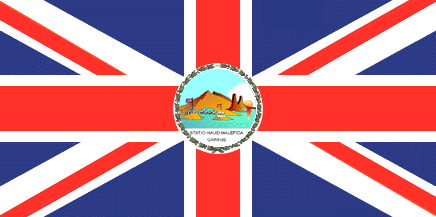
Administrator (?) (doubtful flag, pre-1937)
by Jaume Ollé, 18 October 2002
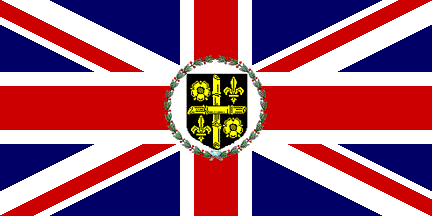
Administrator (from 1937)
by Martin Grieve, 28 September 2002
The governor's flag is (was?) blue with a golden crown with a
lion on it, and under it is a golden ribbon with black text
'SAINT LUCIA', proportions 1:2.
Željko Heimer, 18 March 1997
Until 1960, there was no Governor of St.Lucia as such. The
island was part of the non-federal colony of the Windward Islands
and the relevant flag was that of the Governor of the Windward
Islands. His flag was the usual Union Flag defaced with a white
disc surrounded by a garland of green laurel leaves; badge of the
Windward Islands on the white disc.
Between 1960 and 1967 it is not known to 'Colours of the Fleet'
from which I've taken this information.
Between 1967 and 1979 the 1939 badge of St.Lucia was applied to
the standard defaced Union Flag.
1979: presumably, this was when the blue flag with the lion and
crown was introduced.
David Prothero, 20 March 1997
Three general principles.
1. Administrators were not entitled to a flag.
2. In the Windward Islands the Governor, sometime called
Governor-in-Chief, but not Governor-General,was entitled to a
Union Jack defaced with the Windward Island badge.
3. The badge of each individual island could be used on a
Blue Ensign, but not on a Union Jack.
However, when the "black shield" badge replaced the
pictorial badge in 1937 it was mistakenly thought that the new
badge could be used to deface a Union Jack for the
Administrator. The error was not noticed until 1940. In
1960 the post of Governor of the Windward Islands was abolished.
In 1967 St Lucia became and Associated State and the
Administrator became a Governor.
The flag above:
1937 - 1940: Used officially by mistake.
1960 - 1967: Uncertain whether it was used.
1967 - 1979: Used officially until independence.
David Prothero, 30 September 2002